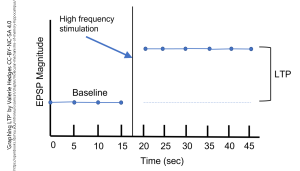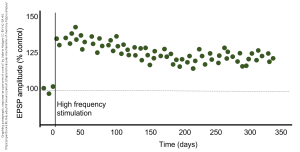Long-Term Potentiation (LTP)
Caleb Bevan
Objective 3: Outline the basic steps in a classic demonstration of long-term potentiation.
 Because it is now the most-studied circuit in neuroscience, we will turn our attention to the Schaffer collateral pathway. Remember that this is a synapse between the CA3 neuron’s axon terminal and the CA1 neuron’s dendrites. We stimulate the CA3 axons and record, using an intracellular glass electrode, from the cell body of the CA1 cells where (as we recall) the graded potentials sum together.
Because it is now the most-studied circuit in neuroscience, we will turn our attention to the Schaffer collateral pathway. Remember that this is a synapse between the CA3 neuron’s axon terminal and the CA1 neuron’s dendrites. We stimulate the CA3 axons and record, using an intracellular glass electrode, from the cell body of the CA1 cells where (as we recall) the graded potentials sum together.
 First, we stimulate a single action potential in the CA3 axons, which causes the release of neurotransmitter from the CA3 axon terminals, and record the size of the summed EPSPs from the dendrites of the CA1 cell using the glass electrode placed in the CA1 soma. We stimulate the CA3 axons with a stream of electrical pulses, which triggers a stream of action potentials. The term of art used to describe this method is tetanic stimulation. The action potentials are arriving about as fast as they possibly can, with only 5 msec between action potentials. That is, there are 200 action potentials per second, a frequency of 200 Hertz (Hz). (A Hertz is a unit, named for a German physicist, which means “per second”.) After such a burst of action potentials, we collect another set of recordings.
First, we stimulate a single action potential in the CA3 axons, which causes the release of neurotransmitter from the CA3 axon terminals, and record the size of the summed EPSPs from the dendrites of the CA1 cell using the glass electrode placed in the CA1 soma. We stimulate the CA3 axons with a stream of electrical pulses, which triggers a stream of action potentials. The term of art used to describe this method is tetanic stimulation. The action potentials are arriving about as fast as they possibly can, with only 5 msec between action potentials. That is, there are 200 action potentials per second, a frequency of 200 Hertz (Hz). (A Hertz is a unit, named for a German physicist, which means “per second”.) After such a burst of action potentials, we collect another set of recordings.
Now the EPSPs are much larger than they were before. In other words, the synapses have become more effective at stimulating graded potentials in the dendrites of the postsynaptic cell. We say that long-term potentiation (LTP) has occurred.
This effect lasts for as long as we can keep the slice alive, perhaps 24 to 48 hours depending on the skill of the investigator and a bit of luck. Human memories last a lifetime, perhaps 100 years. Does this effect last for the lifetime of a rat? Rats live about 2-4 years, at most, but there is no way we can keep a hippocampal slice alive that long. To answer this question, we have to switch to a different method, one that uses an electrode permanently implanted in the CA3 region of the hippocampus of a living rat. (The term of art is an awake, behaving rat.)
 The results of such an experiment in an awake, behaving rat are shown here. Even weeks or months of that single tetanic stimulation, the CA3 to CA1 synapses are more effective than they were before the experiment began. This is much longer than the lifetime of a neurotransmitter molecule, and much longer than even the lifetime of a single receptor protein. Something profound must be happening here, something that involves more than just an increase in the number of receptors or increase in transmitter release. It seems we have found a way to modify synapses for the lifetime of the organism. Now it remains for us to discover the molecular- and cellular-level mechanisms that underlie this amazing result.
The results of such an experiment in an awake, behaving rat are shown here. Even weeks or months of that single tetanic stimulation, the CA3 to CA1 synapses are more effective than they were before the experiment began. This is much longer than the lifetime of a neurotransmitter molecule, and much longer than even the lifetime of a single receptor protein. Something profound must be happening here, something that involves more than just an increase in the number of receptors or increase in transmitter release. It seems we have found a way to modify synapses for the lifetime of the organism. Now it remains for us to discover the molecular- and cellular-level mechanisms that underlie this amazing result.
Media Attributions
- Schaffer collateral LTP Hedges © Valerie Hedges is licensed under a CC BY-NC-ND (Attribution NonCommercial NoDerivatives) license
- Graphing LTP Hedges is licensed under a All Rights Reserved license
- Graphing PSP as percent control Hedges is licensed under a All Rights Reserved license

